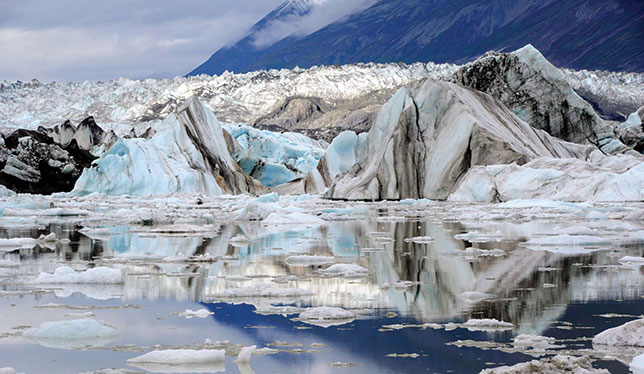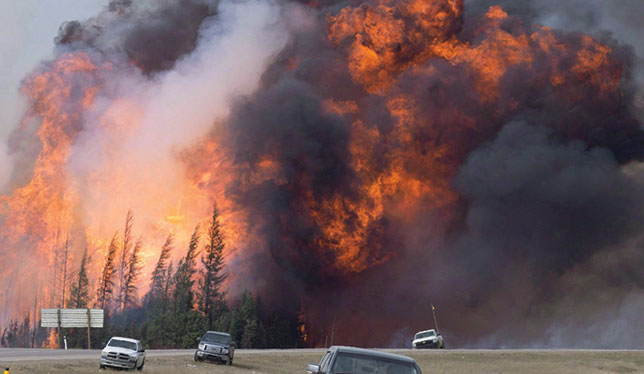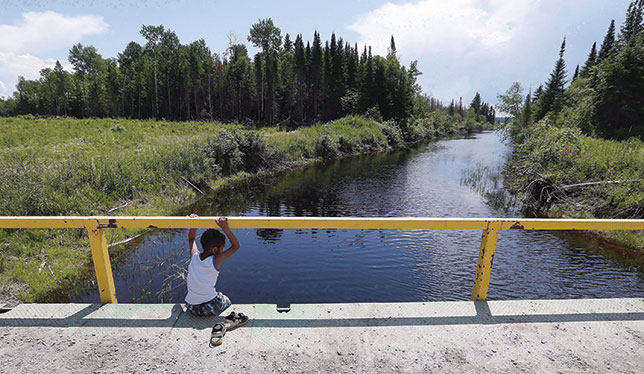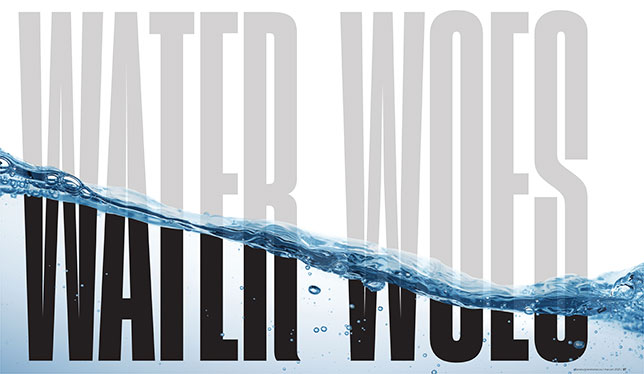In 2018, Cape Town was steadily inching toward Day Zero. Three years of punishing drought had reduced the city’s rain-fed reservoirs to just 17 percent capacity. It seemed possible that the South African metropolis might become the first major city in the world to run out of water. Luckily, disaster was narrowly averted when rain arrived in the fall of 2018 and restored the water supply.
But scientists warn that, as the planet continues to warm and extreme weather events become more common, scenarios similar to what transpired in Cape Town will surface in other parts of the world. Even Canada is not immune to this threat. In fact, some places in Canada have already had to cope with water shortages.
In 2015, Regina and Moose Jaw, Saskatchewan, had to ration water supplies due to an inability to treat a toxic algae bloom in Buffalo Pound Lake, which supplies drinking water to both cities. In 2016, a summer drought led to water restrictions in southern Ontario and Nova Scotia, and in 2018 stringent water restrictions were imposed on many southern Alberta communities and farms due to reduced river flows. Even Vancouver, a city perched on the edge of a rainforest, has recently begun rationing summer water use due to a combination of rising consumer demand and a shrinking of the mountain snowpack that supplies the city’s reservoir.
“Every community and province needs a drought plan – how they will deal with water shortages to maintain supplies to priority users and how they will apportion water when it runs short.”
“The Vancouver situation has some eerie parallels to Cape Town,” says John Pomeroy, a world-renowned hydrologist at the University of Saskatchewan who has spent three decades studying ways to reduce the impact of water-related natural disasters. Dr. Pomeroy believes that Canadian municipalities should be looking at ways to store water and encourage reduced consumption. “Every community and province needs a drought plan – how they will deal with water shortages to maintain supplies to priority users and how they will apportion water when it runs short.”
Dr. Pomeroy is no alarmist. As holder of the Canada Research Chair in Water Resources and Climate Change and director of the University of Saskatchewan’s Global Water Futures research program, he is knee-deep in the latest H2O data. Dr. Pomeroy describes GWF as “the largest university-led freshwater research program in the world.” Founded in 2016 with an initial investment of $77.8 million through the federal Canada First Research Excellence Fund, the seven-year venture has since expanded to a budget of $330 million. That money funds a network of 190 professors and some 900 graduate students, researchers and scientists from 15 Canadian universities, including three key partners: the University of Waterloo, McMaster University and Wilfrid Laurier University.
The fact that Canada faces real threats to its water security will surprise many Canadians, as the popular perception is that we are a country with a virtually inexhaustible supply of water. “It’s a myth of abundance and it has affected water policy. It’s allowed us to be a little bit lazy,” says Rob de Loë, a professor in the faculty of environment, resources and sustainability at the University of Waterloo and a member of its Water Institute.
Dr. de Loë notes that much of Canada’s water is simply not accessible. Although we possess about 20 percent of global freshwater resources, only seven percent is considered renewable – and most of that drains north toward Hudson’s Bay and the Arctic Ocean, putting it out of reach of the roughly 90 percent of Canadians who live within 160 kilometres from the nation’s southern border. “You tell people in Ontario that we have a limited amount of water and they will point to the Great Lakes and laugh,” he says. “But you can only take a modest amount of water from the lakes without doing damage. The lakes aren’t like a keg at a college beer party where you empty one, then just roll out another one.”
A number of water experts contend that Canada’s approach to water management badly needs revamping. In her 2016 book Boiling Point: Government Neglect, Corporate Abuse and Canada’s Water Crisis, author Maude Barlow describes our existing water protection regulations as uneven and generally inadequate. “They are a patchwork of outdated, vague and even conflicting regulations with no coherent overarching principles or rational planning,” she writes. “Many of our laws were originally enacted well over a century ago for a country that was still largely rural and agrarian and whose population mostly extracted water for their own use.”

As it stands, portfolios such as agriculture, health, water and wastewater treatment are shared between multiple agencies and levels of government, while water itself flows across municipal, provincial, territorial and sometimes national boundaries. The federal government notes that no less than 20 federal departments and agencies share responsibility for freshwater across Canada.
This type of siloed structure leads to organizational paralysis. “When there is a problem, no one wants to own the problem. We have a need for an overriding agency,” says Banu Örmeci, a professor of environmental engineering who holds the Jarislowsky Chair in Water and Global Health at Carleton University. She also serves as the director of the university’s Global Water Institute, a multidisciplinary cluster of more than 100 researchers focused on addressing domestic and international water challenges.
Dr. Örmeci says that this same pattern of fragmentation hampers water research. “We are doing a project right now involving climate change with the National Research Council of Canada. It’s difficult to find data. It’s all scattered in different locations.”
Even something as basic as drinking water suffers from this disjointed approach. Incredibly, there is no federal law that governs the standard for drinking water. The job is left to the provinces, which create their own guidelines. The drawback with this is consistency. As Dr. Pomeroy notes, “You end up with a mixture of standards. Some provinces do a great job and some don’t.”
The piecemeal division of responsibilities has made it difficult to generate and implement a national vision for water management. But the need to develop one is becoming increasingly urgent, especially when one considers that the major natural disasters most likely to afflict Canadians – drought, flooding and forest fires – are closely tied to water and that all three are expected to increase in severity due to climate change. The GWF estimates that $28 billion has already been spent responding to and repairing the impacts of climate-related water disasters between 2000 and 2017.
During the next five years, flooding alone is expected to cost the federal government’s disaster assistance fund more than $650 million a year. Yet, despite this looming threat, Canada is the only G7 country without a national flood-forecasting system. “We held a meeting in February 2019. It was the first time that Canada’s flood forecasters had ever met each other,” says Dr. Pomeroy.
“As temperatures rise, the mountain snowpack is melting faster and earlier. As a result, the water is moving through river basins more quickly than in the past and leaving them parched by the end of summer.”
A recent study of 16 Canadian cities, conducted by the Intact Centre on Climate Adaptation at U of Waterloo, found that these municipalities had made little progress to limit their risk of flooding over the past five years, scoring an average of C+ in flood-readiness. If a large-scale flood were to occur this spring, the impact on Canadians, compounded by the pandemic, could be “catastrophic,” said Blair Feltmate, co-author of the study and head of the centre.
In Western Canada, flooding and drought are both directly affected by the snowpack conditions in the Rocky Mountains. The snow that falls here provides everything from drinking water to irrigation for agriculture for tens of millions of people across North America. “But we’re gradually losing it,” says Dr. Pomeroy. “As temperatures rise, the mountain snowpack is melting faster and earlier. As a result, the water is moving through river basins more quickly than in the past and leaving them parched by the end of summer.”
We are also losing our glaciers, which supply water flow in late summer and fall when other stream components are small. Glacial coverage on the Albertan side of the Rockies has declined by as much as 25 percent, and at least 300 glaciers have vanished entirely, in the past 30 years.
Parched conditions in the west have fueled the threat of major forest fires, such as the immense Fort McMurray wildfire in Alberta in 2016. The conflagration caused the evacuation of almost 90,000 people and became the most expensive natural disaster in Canadian history, destroying 2,400 buildings and causing an estimated $10 billion in damage.

In British Columbia, where forest fires have been burning at a record pace, forestry experts warn that the province may soon have to contend with wildfires on a scale similar to those that recently devastated Australia. The increase is not thought to be entirely a product of climate change, but it is certainly a key factor. Longer-lasting heat waves suck the moisture out of the forests, making them susceptible to ignition from lightning and human carelessness. A report by the Pacific Climate Impacts Consortium at the University of Victoria found that B.C.’s 2017 wildfire season may have been up to 11 times more destructive due to the effects of climate change.
Forest fires also pose a threat to drinking water, says Dr. de Loë. “Forest fires can deliver suspended solids and nutrients like dissolved organic carbon and bioavailable phosphorus that can lead to conditions that challenge drinking water treatment operations beyond their response capacities.”
Another destructive side-effect occurs at high altitudes where soot from the fires is darkening glacial ice. The darker colour absorbs more sunlight, melting the ice. “Parts of the glaciers look as dark as an agricultural field,” says Dr. Pomeroy. “There is algae growing on the ice now and it’s helping to hold the soot in place. This was never a part of the predictive models we had. It’s been a nasty surprise.”
Another water-related issue that rarely makes the headlines is the lack of clean drinking water in remote communities. It is more prevalent than one might suppose, notes Lee Jackson, a professor of evolutionary biology at the University of Calgary who has been studying water supplies for both small rural communities and larger centres. “On July 7, 2020, for example, there were 750 boil-water advisories in Canada,” says Dr. Jackson.
A national shame
Although most Canadians have access to clean, safe drinking water, this is not true for many of the residents of First Nations communities, where drinking water may be contaminated, difficult to access or at risk due to faulty treatment systems.
A lack of clean, safe drinking water is a violation of the UN-recognized human rights to water and sanitation, and yet some First Nations have been dealing with boil-water advisories for more than two decades. In 2016, the Canadian government announced a plan to remove all advisories by March 2021, in addition to repairing and replacing water treatment facilities. However, it recently admitted that it was unable to meet that deadline.
Even so, considerable cash has been thrown at the problem. Since forming government, the Liberals have spent $1.65 billion of $2.19 billion set aside to build and repair water and wastewater infrastructure, and to manage existing systems on reserves. In December 2020, Indigenous Services Minister Marc Miller pledged to spend $1.5 billion in additional investments to finish the work, and $114 million per year ongoing thereafter to support daily operations and maintenance for water infrastructure on reserves. Ottawa also claims it has ended 96 long-term boil water advisories so far, but still faces 60 in 41 communities (some First Nations rely on more than one system).
For the affected communities, it is just one more in a long string of broken promises. Many of the problems derive from bureaucratic paralysis. Safe water is normally the responsibility of the provincial governments, but First Nations and the reserves they live on fall under the jurisdiction of the federal government. This governance structure means that, while most communities benefit from binding provincial water quality regulations, there are no such enforceable regulations on reserves.
Also, unlike every province and territory in Canada, no specific legislation exists on exactly what the federal government is supposed to deliver, or which communities are eligible. There is no consistency as to how water problems are dealt with from reserve to reserve, and when problems arise, it’s unclear whether First Nations leaders or the federal government is responsible.
An example of the ongoing impasse is on display at the Six Nations Reserve of the Grand River in Southern Ontario. In 2013, the federal government installed a $41-million water treatment plant with the capacity to service the entire reserve, Canada’s largest, with a population of 12,000, but only 11 percent of households are hooked up to it. The cost of connecting the entire community is pegged at $200 million.
“You can’t drink the water that comes out of the taps or the wells. It’s contaminated with heavy metals,” says Dawn Martin-Hill, a Mohawk who holds the Paul R. MacPherson Chair in Indigenous Studies at McMaster University, and who lives on the reserve. Frustrated residents have to purchase bottled water to drink. “This should be seen as a health crisis,” she says. “If this was happening in a white suburb, something would be done. It’s a matter of systematic racism.”
“It is hard for city folk to imagine the problem,” says Madjid Mohseni, a professor of chemical and biological engineering at the University of British Columbia. “These people have to be careful to never drink the water. They may have children in the house and so the psychological pressure is enormous. Some are fly-in communities where the bottled water has to be delivered. But what if the water doesn’t arrive?”
Dr. Jackson says there are technological solutions available to help these communities and that researchers at U of Calgary’s faculty of science have devised a drinking water and wastewater treatment system scaled to a community of 750 to 1,000 people. “It’s an on-the-ground solution to the water issues of remote communities, with value-added components: biofuel production, a greenhouse, and the production of phosphorus-rich fertilizer, which can be used by the community or sold for profit,” says Dr. Jackson.

“This technology exists and is being used in the Netherlands. The issue is that we need to find a way to get this into communities. The cost is approximately $1.5 million per community. This work is at a concept stage and we’re trying to find communities that are willing to partner with us.”
Another issue with water treatment plants is that their design must be appropriate to the target community. “Are there people living there with the skill set to operate them? It’s vital to select the right technology for the setting,” says Dr. Mohseni, who also serves as the scientific director for the RESEAU Centre for Mobilizing Innovation, headquartered at UBC and funded by the Natural Sciences and Engineering Research Council. The group, which works with various partners, offers solutions for remote Canadian communities that have problems obtaining clean drinking water either due to organic contaminants or some form of heavy metals pollution. These communities range in size from a couple of households to about 2,000 people.
Dr. Mohseni says his group found it needed to get the individual communities involved in the projects and listen to their concerns if they were to be successful. “It’s essential to understand the values that are held by these remote communities because they may not be the same as our own. This is even more critical with First Nations communities.”
Dr. Jackson says that the traditional government approach has been to administer solutions from the top down, a strategy that often ignores consequences. “The federal government just announced it was going to spend $1.5 billion on water treatment in Indigenous communities, but nowhere is there any mention of what they intend to do with wastewater produced in these plants. It’s a major concern of people in these communities.”
Oliver Brandes believes that formulating more meaningful water policies means changing the mindset that sees water as a resource to be extracted to one that needs to be nurtured and preserved. Dr. Brandes, who is co-director of the POLIS Water Sustainability Project based at UVic’s Centre for Global Studies, believes Canada’s national approach to water security needs to be overhauled. This overhaul should focus on modernization of the Canada Water Act (which has not been modified since it was passed in 1970), and policy renewal “that focuses on building climate change resilience, advancing reconciliation with Indigenous peoples and ensuring effective water governance.”
Carleton’s Dr. Ormeci says Canada has been slow to change regulations and adopt new water policies that reflect current conditions and demographics. “We don’t do enough to protect our water resources. Up until 2012 we didn’t even have a legal standard for treating wastewater effluent,” she says. In fact, until very recently several Canadian coastal cities continued to dump raw sewage directly into the ocean.
The last holdout, Victoria, which was spewing 130 million litres of raw sewage daily directly into the Juan de Fuca Strait, announced this past December that its new $775-million wastewater treatment plant was finally up and running. The plant took over four years to build but decades of debate to finally get started as local politicians contended that the natural currents in the strait created the “perfect flush.”
“There is always a lag behind the scientific understanding of an issue and the incorporating of the science into engineering decisions,” says Ali Nazemi, an assistant professor in the department of building, civil and environmental engineering at Concordia University. “Making things more difficult is climate change, which is moving at an unprecedented rate,” adds Dr. Nazemi, who is also director of the Water Security and Climate Change lab at Concordia. “It’s even more of a problem in Canada, where the temperature is rising at twice the global average. In the North, it is increasing at three times the global average.”
Fortunately, help may be on the horizon. This past year, Prime Minister Justin Trudeau instructed the minister of environment and climate change to establish a Canada Water Agency that will “work together with the provinces, territories, Indigenous communities, local authorities, scientists, and others to find the best ways to keep our water safe, clean and well-managed.” An online national panel discussion, involving more than 650 scientists and water management professionals that took place on May 13, 2020, marked the start of a series of national and regional discussions that are expected to inform the development of the new agency.
Dr. Nazemi senses an opportunity. “There are a lot of good things happening on the research side. I believe we can apply the lessons we have learned to other countries. We could become exporters of science to the world. We have the expertise and we also have a head start because we are already dealing with these warming questions.”
In the meantime, more research needs to be done, says Dr. Pomeroy, pointing to problems of diminished groundwater quality, shrinking lake ice, the growth of toxic algae in lakes, thawing permafrost in Canada’s North, and the lack of empowerment of Indigenous communities to manage their own water sources.
Looming over the entire issue is the spectre of climate change. “As we lose our snow and ice, floods can happen anytime of the year, droughts can be more severe, and our hydrological stability is lost. Our rivers become much more dangerous, more variable and less predictable,” says Dr. Pomeroy. “Climate change is like going down some pretty terrifying rapids, and it’s going to take expert canoeing to get through this.”

The statement “In 2015, Regina and Moose Jaw, Saskatchewan, had to ration water supplies due to an inability to treat a toxic algae bloom in Buffalo Pound Lake, which supplies drinking water to both cities.” is inaccurate and misleading.
Algae blooms have never prevented the Plant from being able to treat water and meet the demands of the Cities or the Region it serves. The Plant was upgraded in the 1980’s specifically to address problems associated with highly eutrophic water and cyanobacteria algae blooms. Approximately one million kilograms of granular activated carbon is used during bloom season. The carbon effectively removes offensive taste, odours and hepatotoxins produced by blooms of cyanobacteria at the flow rates the Plant is designed to treat. The Plant can also add powdered activated carbon to further assist removal of algal derived problems.
The production issues that occurred in 2015 were settling issues caused by thermal stratification in the shallow lake. Rapid rises in surface water temperature during the day and very little wind to adequately mix with the cooler water in the depths of the water column caused a condition known as short circuiting in the Plant. This led to the settling issues which could only be solved by decreasing output from the Plant. It was purely a physical problem and not biological.